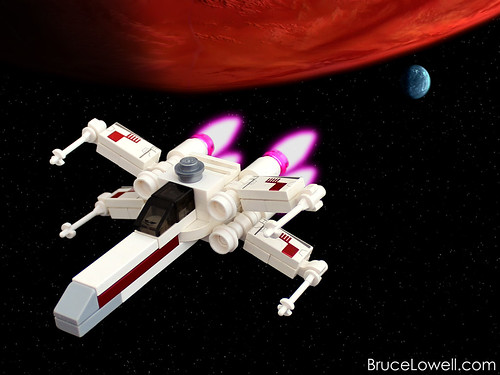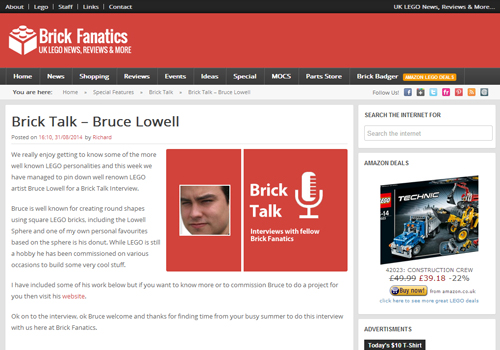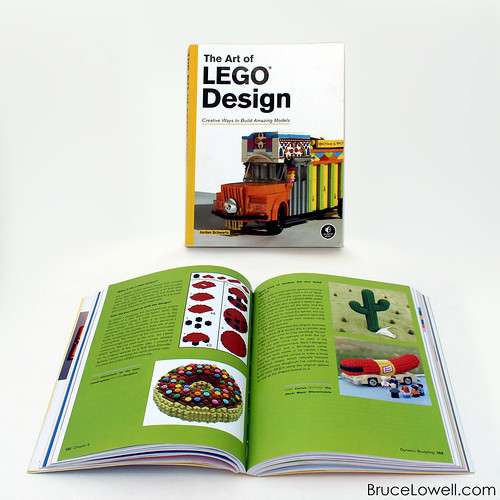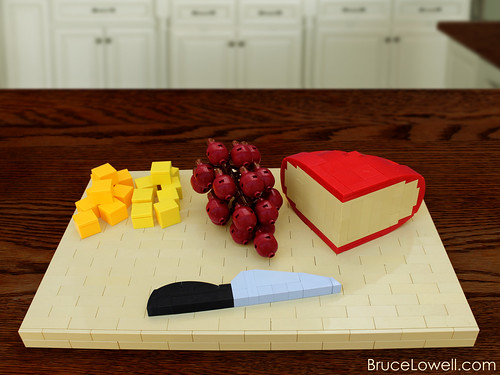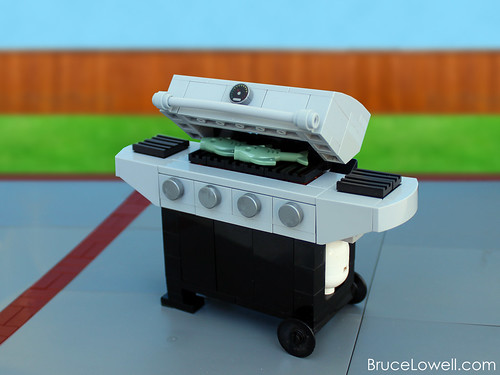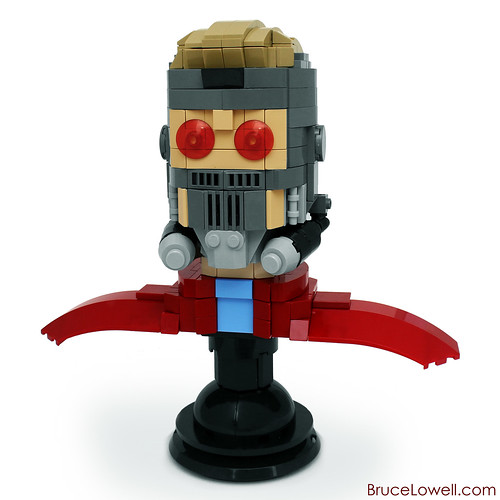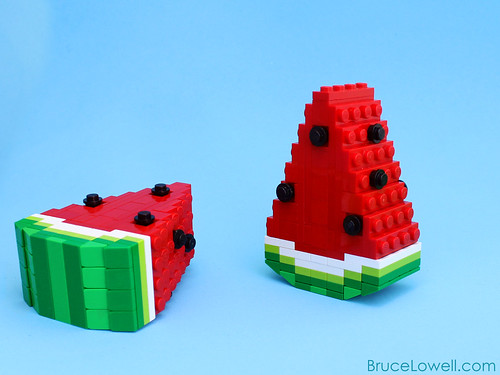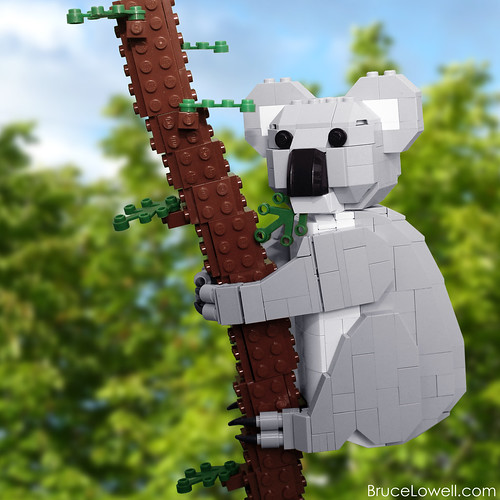Standard Swingline stapler, in LEGO form. An homage to Jimmy’s stapler from last year.
Mini X-Wing
Brick Fanatics – Brick Talk Interview
Check out my Brick Talk Interview with Richard at Brick Fanatics, in which we discuss my LEGO hobby in twenty questions.
The Art of LEGO Design
Jordan Schwartz’s book The Art of LEGO Design came out back in June. It is filled with some of the best creations by the leading AFOLs in the community including Mike Nieves, Nannan Zhang, Tyler Clites and, of course, Jordan Schwartz. I also happen to have some content in there. This book is great for any new or seasoned builder looking for inspiration or just to pass the time.
The section on Dynamic Sculpting has a nice four page write-up on the Lowell Sphere (pictured above), with instructions and several examples of its application, including my donut, cactus, and Oscar Mayer Wienermobile!
Cheese Platter
Barbecue Grill
Summer is well underway and, having been using my grill a lot lately, I decided to try building another LEGO grill. Be sure to check out my Weber Barbecue Grill from 2012.
Star-Lord Bust
Watermelon
Koala
In Which I Redesign My LEGO Wall
This past month I undertook a project several years in the making, and at least one year overdue: redesigning my main LEGO wall. This is what my wall looked like as of the start of the project:


I wanted to document this process since I’ve received a lot of questions and comments over the years about my LEGO organization. If you follow me on Instagram, you might’ve seen some in-progress shots of one side of the wall. Also, since today is the two year anniversary of my website going public, I thought I’d try posting something new and different.
I’ve been using the above space as my LEGO studio for about five years now, and my vision for what I need and want out of the space has vastly changed in the time that I’ve been building in it. This wall, for instance, was originally intended to hold up at least forty-five Stack-On containers (they make 18, 39, and 60 drawer options in this size). This was my main means of organizing my LEGO bricks between roughly 2003 to 2010, and it worked well in my previous work space.
 Many factors, including the increasing size of my collection, the depth of the drawers and the change in building space, caused me to almost completely outgrow this method. Back around 2005 I bought forty-eight Sterilite 3-drawer containers, and have moved on to more than double to a current total of 100 (only one will be pictured here). Interesting side note: it’s really crazy seeing the price of the Sterilite containers more than double since I first started purchasing them, from about $5.00 to about $12.00 on average.
Many factors, including the increasing size of my collection, the depth of the drawers and the change in building space, caused me to almost completely outgrow this method. Back around 2005 I bought forty-eight Sterilite 3-drawer containers, and have moved on to more than double to a current total of 100 (only one will be pictured here). Interesting side note: it’s really crazy seeing the price of the Sterilite containers more than double since I first started purchasing them, from about $5.00 to about $12.00 on average.
 I’ve become very fond of using Darice bead organizers mostly because of their price (consistently $2.00 each) but also for their functionality for sorting specific smaller elements that need more separation than a Stack-On or Sterilite drawer will offer.
I’ve become very fond of using Darice bead organizers mostly because of their price (consistently $2.00 each) but also for their functionality for sorting specific smaller elements that need more separation than a Stack-On or Sterilite drawer will offer.
 Over the years, certain part types and colors have outgrown single Darice containers. I was searching for a few different options (including using two Darice containers for single part types) but finally settled last year on Plano organizers for their versatility, compatible size (two Darice containers fit perfectly on top of one Plano container) and price (about $2.50 each; I got really lucky and found a bunch on massive discount).
Over the years, certain part types and colors have outgrown single Darice containers. I was searching for a few different options (including using two Darice containers for single part types) but finally settled last year on Plano organizers for their versatility, compatible size (two Darice containers fit perfectly on top of one Plano container) and price (about $2.50 each; I got really lucky and found a bunch on massive discount).
Now that we’re past the primer on the types of containers I use and why, we can get on to the whys and hows of this remodel. As I mentioned, my collection outgrew the Stack-On containers but the original shelving I used was still geared specifically for them. The containers were bolted to the wall, and because of how I made the shelving, they were angled back so that when an earthquake hits (when, not if; California’s due for one soon!) the containers and drawers shouldn’t fly forward. The shelves were only 8″ deep, and the Darice bead organizers are about 11″ wide and the Plano containers about 11″ deep, so both stuck out around 3″. I also needed more shelves between the original three levels meant for the Stack-On containers, so that the Darice and Plano containers wouldn’t be stacked too high and/or putting too much weight on the shelves.
The original wood paneling on the wall was nice (I guess), but a big chunk was missing out of the top right corner. I wanted to have lighter walls (that actually covered the entire wall) and that would allow for more shelves above the top shelf, maximizing the amount of shelving and allowing for growth in the future; if there’s one thing I’ve noticed about my LEGO collection is that it only gets bigger. Lastly, I wanted the shelves to be legitimately earthquake proof; having not just more and deeper shelves, but shelves that would secure the containers on them when the next big quake comes around. After much note taking, plan drawing, and cost calculating, I was ready to go.
original wood paneling on the wall was nice (I guess), but a big chunk was missing out of the top right corner. I wanted to have lighter walls (that actually covered the entire wall) and that would allow for more shelves above the top shelf, maximizing the amount of shelving and allowing for growth in the future; if there’s one thing I’ve noticed about my LEGO collection is that it only gets bigger. Lastly, I wanted the shelves to be legitimately earthquake proof; having not just more and deeper shelves, but shelves that would secure the containers on them when the next big quake comes around. After much note taking, plan drawing, and cost calculating, I was ready to go.
TL;DR: Wall bad, need to make good.
Continue to Page 2 in which we’ll tear down and rebuild the wall!

